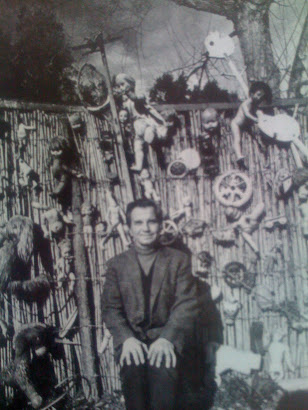
“Salvatore Meo: Assemblages 1948 – 1978,” the largest post-war period exhibition by the pioneering collage and assemblage artist – and Philadelphia native – Salvatore Meo (1914-2004) is being presented at the Rosenwald-Wolf Gallery at The University of the Arts, October 15 – November 26, 2008. The show is being held in conjunction with a companion exhibition at New York’s Pavel Zoubok Gallery.
One of the first American artists to use found objects prior to the 1950s revival of interest in the Dada movement, Meo studied at The University of the Arts, Temple’s Tyler School of Art and the Barnes Foundation. He worked in Stanley Hayter’s atelier and was involved with the Philadelphia Print Club. A 1949 Tiffany Foundation grant enabled the 35-year-old to study in Italy and by 1951, he was a permanent resident in Rome and began exhibiting there, with a solo exhibition at the Vetrina di Chiurazzi Gallery., Meo served as the U.S. arts editor for the important post-Futurist review Arti Visive , through which he actively promoted his Italian colleagues in Philadelphia and New York, where he kept a second studio.
Meo created mixed media constructions with an interest in drawing and gestural abstraction. His work drew upon the humblest of materials – broken and/or discarded objects from the street such as dresser drawers, toys, clothing scraps, torn packages, shoes heels, bones, string and rusted wire In contrast to his contemporaries Robert Rauschenberg and Mimmo Rotella, Meo rejected the seductive imagery of the commercial world. His works reverberated with a melancholy and sense of alienation, reflecting not only his estrangement from the cultural mainstream, but his deep empathy for the dispossessed.
Meo garnered serious attention from leading Italian avant-garde critics and artists. He exhibited widely during the 1950s, with Burri, Capogrossi, Dorazio, Matta, Prampolini, Rotella and others. While Meo’s pioneering use of found materials eluded general audiences, his influence on the artists of the period and those who followed was almost universally acknowledged by progressive critics. Meo’s political rejection by the jury of the 1956 Venice Biennale was reversed by his inclusion in the next Biennale. Three years later, William C. Seitz included Meo in his seminal “The Art of Assemblage” at the Museum of Modern Art in New York. This was the first major museum survey of the medium and included important works by Picasso, Schwitters, Rauschenberg, Bontecou, Rotella and many modern and contemporary masters. Simultaneously, the Charles Egan Gallery presented a solo exhibition of Meo’s assemblages from 1946-1961, with favorable reviews published in The New York Times and Art News. Later, noted Italian critics Emilio Villa and Mario Diacono presented Meo at the Metropolitan Gallery in Rome. Despite their best efforts, Meo remained outside of the mainstream, a condition perpetuated by the artist’s life-long ambivalence toward the commercial art world.
An “artist’s artist” and equally important a “critic’s artist,” Meo left a deep impact. The catalogue from his 1971 exhibition at Rome’s CIAK gallery documented his influence with writings by key Italian art world writers
After his death in 2004, the Fondazione Salvatore Meo was created to preserve and promote his rich artistic legacy. His studio directly behind the Trevi fountain has been preserved in its original state and is home to hundreds of works spanning five decades. The Rosenwald-Wolf Gallery exhibition is presented in collaboration with the Italian Cultural Institute of New York.
Rosenwald-Wolf Gallery @ The University of the Arts (Sid Sachs, Director: 215/717-6480)
333 S. Broad Street, Philadelphia, PA 19102

Nessun commento:
Posta un commento